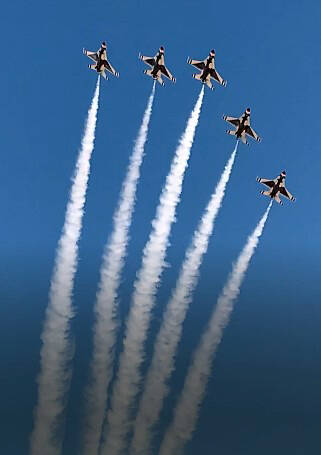
Many oldtimers fondly remember the comic book and television versions of “Superman,” and the astonishment of the anonymous characters when they saw something foreign flying overhead — “It’s a bird, it’s a plane, it’s Superman!”
Here in Nevada, people are still somewhat astonished when they see certain objects flying overhead performing aerial acrobatics. But in the latter case, it’s the U.S. Air Force Air Demonstration Squadron, the Thunderbirds. The group performs precision aerial maneuvers demonstrating the capabilities of Air Force high-performance aircraft to people throughout the world.
Young pilots — and would-be pilots — often wonder how hard it is to become a Thunderbird. Candidates for the ace aerobatic team must have at least 1,000 flying hours on a jet fighter and must be current on the F-16. And all candidates for the Thunderbirds must have at least three years (but no more than 12 years) of military service. Maj. Lauren “Threat” Schlichting is one of only six female pilots in the 69-year history of the squadron.
The organization gets its name from the legend of the thunderbird, which in Native American mythology is a powerful spirit in the form of a feathered vertebrate. By its work, the earth was watered and vegetation grew. Lightning was believed to flash from its beak, and the beating of its wings was thought to represent the rolling of thunder.
Each team member has a specialty. The commander/leader is Lt. Col. Justin Elliott. The position of left wing is held by Maj. Ian Lee and right wing is held Schlichting. The slot position is held by Maj. Zane Taylor, lead solo by Maj. Kyle Oliver and opposing solo by Capt. Daniel Katz. The operations officer is Lt. Col. Ryan Yingling and advance pilot/narrator is Maj. Jake Impellizzeri.
At a recent invitation-only “Evening With the USAF Thunderbirds,” I had an opportunity to briefly speak with Elliott. One of the questions I asked him concerned the combat-readiness of the Thunderbird pilots. There is little doubt that the men and women who fly their aircraft inches from each other while conducting aerial maneuvers are highly qualified and regularly trained. But should the United States ever have to go to war, what are the qualifications of the Thunderbirds? Elliott was quick to respond that in addition to regular Thunderbird training, the pilots also go through all the normal Air Force training that all its pilots must go through.
The Thunderbirds can be viewed this year at the upcoming Aviation Nation event at Nellis Air Force Base, where the team is stationed. Scheduled for Nov. 5 and 6, the event will feature aerial performers, static displays of numerous aircraft, exhibits, concessions and a kids’ zone. For more information about the air show, go to the Aviation Nation website, https://www.nellis.af.mil/Aviation-Nation/.
So, do younger folks who want to fly fighter jets have to become full-time Air Force members and move up the ranks? Well, there is at least one option when it comes to piloting military aircraft: join the National Guard or Air Force Reserve.
According to published reports, one of the biggest benefits of the guard and reserve is that one can specifically apply to the units that they want to join. If they meet qualifications, they can be hired with no military experience (and before signing any military service obligation) to fly the A-10, F-15, F-16, F-22, or F-35. Happy landings, folks.
Chuck N. Baker is an award-winning journalist and a Vietnam War Purple Heart veteran. He can be heard at 8:30 a.m. each Sunday on KKVV-AM hosting “That’s America to Me” and occasionally on KUNV-FM hosting “America’s Veterans, Today and Tomorrow.”